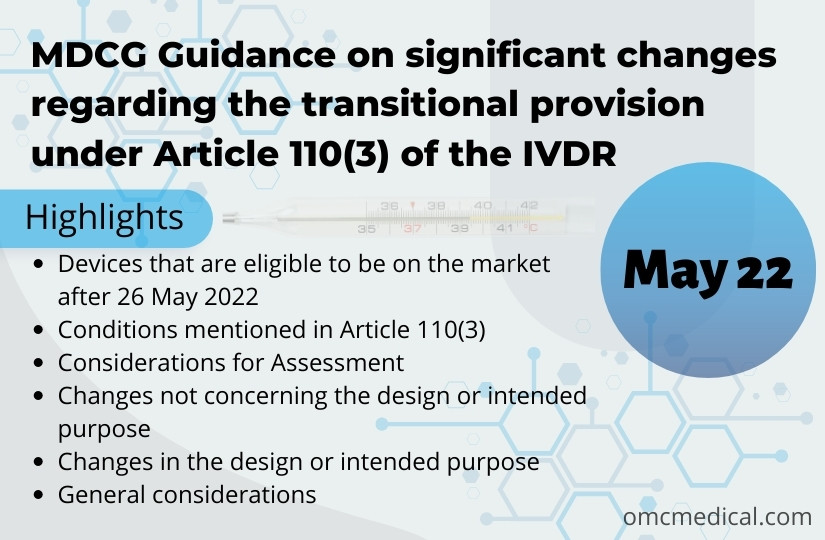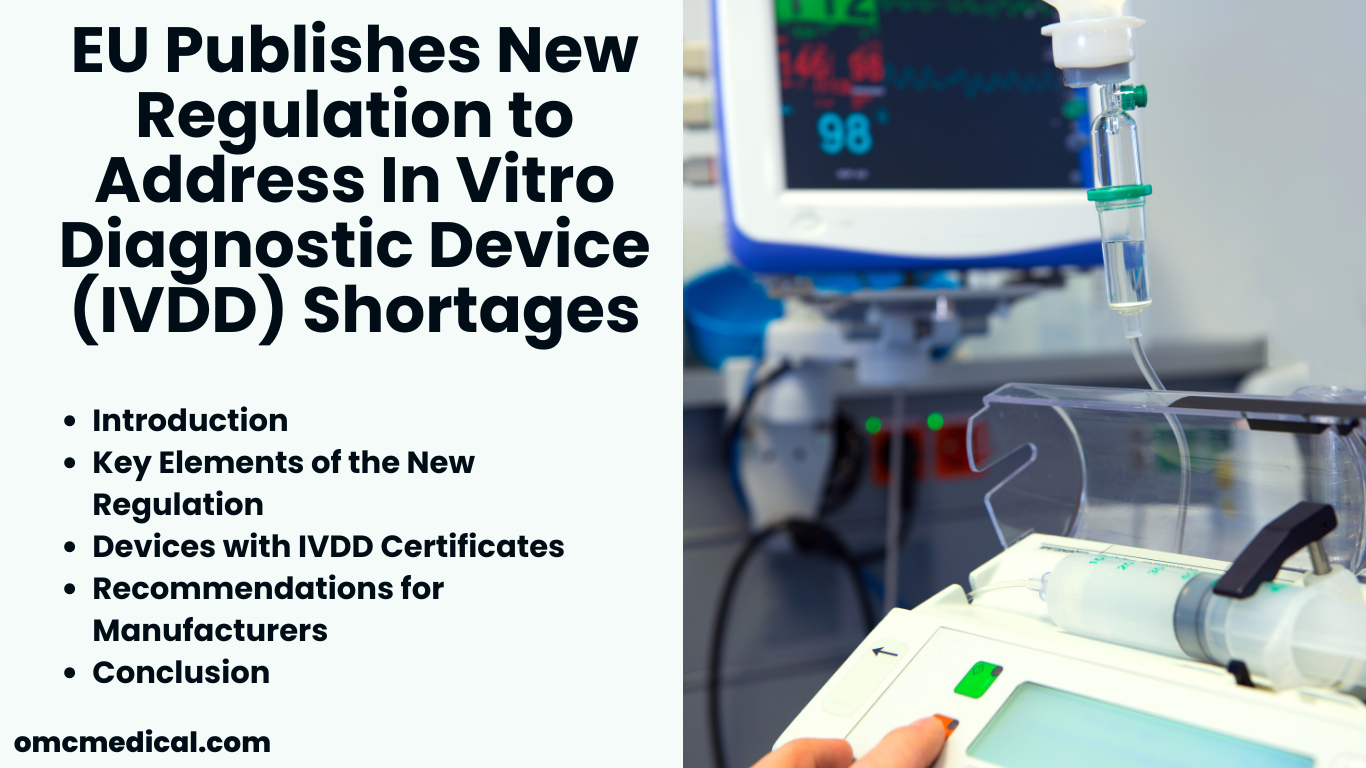MDGC Guidance on significant changes regarding the transitional provision under Article 110(3) of the IVDR aims to provide clarification on the concept of ‘significant changes in the design and intended purpose’.
This article applies to manufacturers of devices that comply with Directive 98/79/EC and is placed on the market or put into operation after the transition period ends on May 26, 2022, irrespective of the involvement of notified body under the IVDD.
It is important to note that IVDR Article 110(3) prohibits the issuance of new IVDD certificates.
Devices that are eligible to be on the market after 26 May 2022
Article 110(3) of Regulation (EU) 2017/746 on in vitro diagnostic medical devices (IVDR), as amended by Regulation (EU) 2022/1121, states that the following devices may be placed on the market or put into service under certain conditions after the IVDR’s effective date, i.e. 26 May 2022, until the end of the various transition periods specified in Article 110(3) IVDR:
- Devices which have a valid certificate issued by a notified body under the Directive 98/79/EC on in vitro diagnostic medical devices (IVDD), and
- Devices for which a declaration of conformity was drawn up prior to 26 May 2022. In accordance with the IVDD and for which the conformity assessment procedure pursuant to the IVDR (contrary to the IVDD) requires the involvement of a notified body
Conditions mentioned in Article 110(3)
The transitional provisions in Article 110(3) IVDR must be applied only if the devices continue to comply with the IVDD and there are no major changes in the design or intended purpose of the device after the IVDR takes effect.
However, requirements of EU 2017/746 relating to post-market surveillance, market surveillance, vigilance, economic operator registration, and device registration will apply and replace the provisions of that Directive.
What are the certificates that remain valid?

Considerations for Assessment
Manufacturers generally will try to avoid any significant changes in the design or intended purpose of the medical device after the date of application of IVDR to benefit from the transition period mentioned in Article 110(3), IVDR.
The two types of changes under which the manufacturers can reap the benefits of the transition period mentioned in Article 110(3), IVDR are the following:
- Changes that do not concern the design or intended purpose
- Change made is not a significant one
In case of the changes mentioned above, the manufacturer can implement the change during the transition period without the need for certification under IVDR but is expected to comply with the documentation requirements of the IVDD.
Additionally, in the case of devices covered by a certificate from the notified body, manufacturers must check with their notified body if the changes belong to the types mentioned above. If so, the notified body will issue a written statement for the same.
The written statement will expire on the date of expiry of the IVDD certificate or 26 May 2025, whichever comes first. The manufacturer is expected to present this written statement and other documentation on request from the market surveillance authorities.
If the conformity assessment procedure under the IVDD requires the QMS to be approved by the notified body, then the manufacturer must ensure that the conditions under which the certificate was granted are maintained.
The point to be noted here is that the existing IVDD certification will not be amended at any time.
Changes not concerning the design or intended purpose
Changes in manufacturer organisation (administrative change) or changes in the manufacturing process must not be considered a change in design or intended purpose even if they are to be mentioned in the information supplied with the device (e.g., Label or instructions for use).
Examples are mentioned in the MDCG guidance documents.
Changes in the design or intended purpose
The flowcharts are given in the annex section of the MDCG guidance document to help manufacturers, notified bodies, and market surveillance authorities decide whether or not a change of the design or intended purpose of the device is considered significant under IVDR Article 110(3).
General considerations
The following changes are NOT to be considered significant changes:
- Changes related to corrective actions assessed and accepted by the competent authority
- Correction of spelling mistakes or merely editorial changes of the information to be supplied with the device (e.g., label or instructions for use)
- Updates of the information to be supplied with the device if they are required by law other than the IVDR (e.g., CLP Regulation (EC) 1272/2008 read in conjunction with Annex I, section 8.3. IVDD) are mere clarifications
and do not adversely affect the devices’ safety and performance in relation to existing or new risks.
The MDCG guidance document on Article 110(3) provides the main flowchart followed by sub flowcharts which are to be used on specific conditions as listed below:
- Chart A – Changes in the intended purpose
- Charts B to E – Changes in the design
- Chart C – Software changes
- Chart D – Changes related to an ingredient or material
- Chart E – Changes related to sterilisation
Please refer to the MDCG guidance document for the above flowcharts and examples.
FAQs
For a device consisting of Software, what is considered significant and non-significant changes?
Non-significant change:
· Bug fixes, updates of standard third-party OS, security updates, the appearance of the user interface, operating efficiencies and Changes in UI which do not affect performance.
Significant change:
· New or major change of OS, any component, modification of architecture, database structure. Change of algorithm, the addition of a new database, required user input replaced by a closed-loop algorithm, presentation of medical data in a new format or by a new dimension or measuring unit.
Does change in Sterilisation impact or be called a significant change?
Non-significant change:
· Change of the sterilisation cycle parameters under the approved QMS, shelf life validated by protocols approved by the notified body
Significant change:
· Change of sterilisation method, including changing a device from ‘non-sterile’ to ‘sterile’, design or packaging changes that adversely affect the sterility assurance or the effectiveness of the sterilisation
Is there an MDCG guidance document that states the Significant changes for devices certified under MDD or AIMDD?
Yes, there is MDCG guidance for transitional provision under Article 120 of the EU MDR.
Disclaimer: Regulations/legislations are subjected to changes from time to time and the author claims no responsibility for the accuracy of information.







